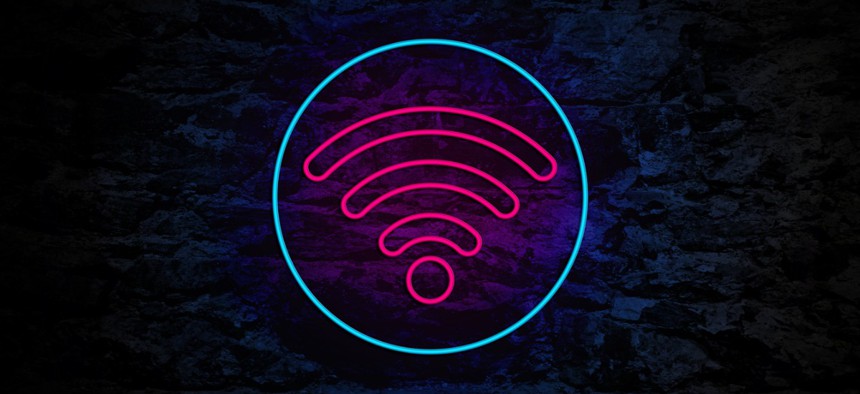Federal Networking Predictions in the Age of Modernization

atakan/iStock.com
This year is poised to be the year of network upgrades.
Federal agencies have made progress with enabling mobility and providing better wireless access to employees working both in office and remote environments. Last year, the pandemic forced many agencies to accelerate their network modernization efforts, first focusing on establishing a network that could sustain such a massive influx of remote workers, then turning to fortify the infrastructure to maintain these capabilities moving forward.
According to a flash poll conducted by the Government Business Council in September, agencies have made strides in modernizing their wireless infrastructures over the past two years, including replacing some older network technology. That said, the survey does reveal that there is still room for improvement.
Enter 2021. This year is poised to be the year of network upgrades. The year agencies place a greater focus on implementing 5G capabilities. A year the federal government takes the next step in its modernization initiatives. Below are a few trends we predict will be of utmost importance to federal agencies over the next 12-18 months in terms of wireless, network and cabling infrastructure.
1. A Renewed Focus on Security
The SolarWinds breach dominated headlines at the end of 2020 (and is still doing so today), which is forcing agencies to refocus their cyber efforts. In fact, the White House recently indicated it is planning "executive action" to address cyber gaps that helped lead to this breach. From a federal networks perspective, this will result in a few key initiatives:
- Locking down vulnerabilities created by new Wi-Fi 6-enabled mobile devices.
- Adoption of alternatives to traditional virtual private network deployments—such as managed Wi-Fi, SD-WAN and encrypted Generic Routing Encapsulation tunneling—to mitigate security risks associated with remote work environments.
- Advancing the security around headless devices, such as the internet of things, by assigning pre-configured virtual local area networks and access control lists to segment and safeguard these devices—both wired and wireless.
- Utilizing Private LTE for on-site wireless connectivity to reduce the risks associated with using the unlicensed spectrum (a.k.a. Wi-Fi).
- Implementing a zero-trust architecture.
2. The Rise of Open Radio Access Networks
Agencies will begin to adopt a new approach to cellular networking called Open RAN where hardware and software components from multiple vendors can operate over network interfaces that are open and interoperable. For mobile network operators, this will eliminate the requirement to rely on a single vendor for their RAN equipment, offering more flexibility and enabling greater innovation. Of note, the Open RAN Policy Coalition was established to advocate for government policies supporting Open RAN, showcasing the important role that government plays in supporting an open, secure, diverse and innovative supply chain for advanced wireless technologies.
3. Delivering Wi-Fi as a Service
Agencies understand the value that an “as-a-service” model offers; that concept can also be considered when it comes to Wi-Fi delivery. Pursuing a Wi-Fi as-a-service approach will take the burden of network management and maintenance off agencies, allowing managed service providers to handle these issues. Under a Wi-Fi as-a-service model, the service provider takes over the existing network(s), or stands up a new network, and then provides management services, allowing the agency to focus on other mission-critical initiatives like modernization, cybersecurity, or advanced data analytics capabilities.
4. Will 5G Become “Mainstream”?
I would be remiss to write a predictions article without mentioning 5G. We all know that 5G is the power behind the full adoption of next-generation capabilities, and we all know that the federal government will need to embrace this technology, with the Department of Defense leading the way through a variety of pilots and testbeds. This is sure to translate to some larger-scale deployments in 2021, but widespread adoption—across the government and commercial sectors—is still a little bit away. That said, 2021 will provide agencies the opportunity to evaluate, upgrade and prepare their infrastructure to be able to support 5G so that they can take advantage of the capability as radio spectrum and 5G-enabled devices become more available. Even with the expansion of 5G, other wireless technologies will still be widely used as 4G and LTE capabilities continue to dominate, and new networks like Private LTE and Wi-Fi 6/6E make inroads.
Nobody anticipated the hard look agencies needed to take at their networks, bandwidth and security as a result of the mass remote workforce generated by the COVID-19 pandemic last year. The modernization efforts that were initiated to support the mobile worker should continue with a focus on upgrading network infrastructure to deliver some of the advanced capabilities noted above. Additionally, both remote workforce network expansion and 5G will require large backhaul capacity expansion in the network. The next 12-18 months in federal networking should be very interesting.
Morné Erasmus is the director of Smart Spaces at CommScope.





